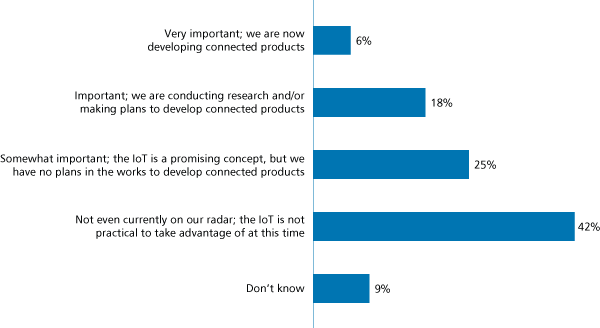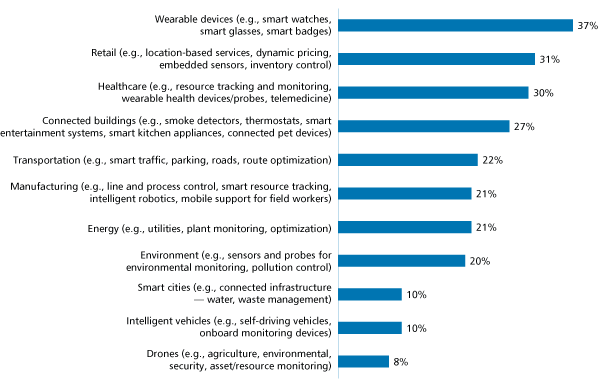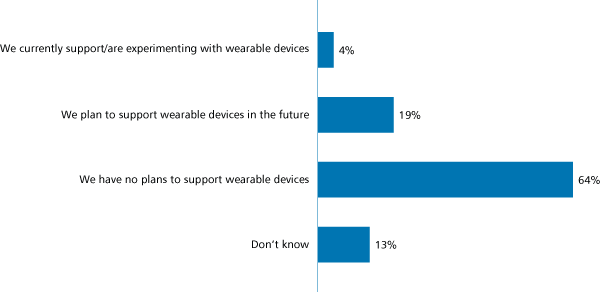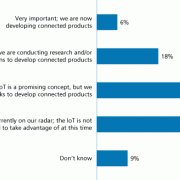DATA ANALYTICS & DIGITAL TECHNOLOGIES VOL. 15, NO. 5


During July-October 2014, Cutter Consortium conducted a survey asking organizations worldwide about their mobile technology plans.1 This included the use of smartphones and tablets to provide employees and partners with the ability to interact with business operations -- ranging from email, Web conferencing, and file sharing to BI and CRM -- on the go.
The survey also considered corporate attitudes and plans toward wearable computing devices, such as smart glasses and smart watches, as well as various connected products associated with the Internet of Things (IoT). Our goal was to determine the extent in which organizations actually utilize mobile technology, the adoption strategies they employ, the value they place on new technologies, and the domains in which they deploy or plan to deploy applications.
We also wanted to identify important issues organizations are encountering in their mobile application development and management efforts and to highlight trends you can use to gauge your own organization's plans and efforts for putting mobile technologies and practices to work.
This Executive Update -- the final in a four-part series2 -- focuses on survey findings pertaining to the IoT, including:
-
How organizations view the IoT in terms of importance
-
IoT technologies that organizations deem most important for their business
-
Organizational support for wearable devices
HOW IMPORTANT IS THE IOT?
The IoT has generated considerable hype, touting how embedded sensors combined with mobile technologies will lead to a multitude of connected devices and services (all generating a deluge of data), which will open up vast opportunities in the consumer, business, technology, and industrial worlds. So we wanted to find out the degree of importance that organizations attach to the IoT, and connected products, in general.
As Figure 1 highlights, nearly a quarter of surveyed organizations consider the IoT either "very important" or "important," and they are currently either actively developing IoT products and services, conducting research, or making plans to develop such offerings. Another quarter believe that the IoT is "somewhat important" and that it holds considerable promise; however, these organizations have yet to formulate any specific plans for developing connected products and services.

Figure 1 -- How does your organization view the IoT, and connected products in general, in terms of importance?
Altogether, almost half (49%) of surveyed organizations currently attach some degree of importance to the IoT. On the other hand, it's apparent that not everyone has bought into the promise of the IoT, if you consider that 42% of organizations are not, at this time, paying much attention to it.
The main points to take away from these findings are: (1) interest in the IoT and the promises it holds are fairly considerable, but (2) organizations currently developing connected products and services are few. And (3) many organizations -- although they might be interested -- feel that it is not very practical to try and take advantage of the IoT (at least not now).
These findings are not surprising. The IoT encompasses many new concepts that require a number of technologies and practices that most mainstream organizations (i.e., those outside the engineering and scientific realms) have little experience with, including designing, implementing, and managing connected applications; sensor data storage and analysis; and machine learning.
There are myriad other issues that need to be worked out before it is more practical for mainstream businesses to implement connected products and services. This includes ensuring corporate network/systems security and customer privacy as well as the development of standard communications protocols and frameworks to allow different vendors' connected products to communicate with each other. And, finally, many organizations simply are unsure at this time as to how to go about gaining business benefit from developing connected products and services.
Organizations and industry groups will eventually work out these issues. Certainly, this won't happen overnight, but the industry appears to be moving in the right direction by forming consortia and focusing technology efforts on these problems. The market is also moving rapidly to address many of the more technical issues, including introducing cloud-based platforms and services designed to take the hassle out of building and managing connected products and analyzing the data they generate.
Consequently, as we move through 2015 and beyond, a lot of the concern surrounding IoT applications and services is going to begin to diminish, with organizations really looking to take advantage of what the IoT has to offer for optimizing the efficiency of existing products and services as well as opening up new lines of revenue and entirely new businesses.
BUT WHICH IOT TECHNOLOGIES AND SOLUTIONS?
Figure 2 shows the IoT technologies and practices that survey respondents say hold the most importance or promise for their organization or business.

Figure 2 -- Which categories of IoT-connected products/solutions hold the most importance or promise for your organization or business?
Wearables
Probably nowhere has the hype surrounding the IoT been greater than when it comes to wearable devices, such as smart watches (e.g., Apple Watch), smart glasses (e.g., Google Glass), activity/fitness trackers (e.g., Fitbit), and smart badges (for location tracking, security, etc.). This includes the use of wearables as general consumer electronic devices as well as for their possible application in business scenarios designed to improve worker performance. Consequently, it's little wonder that wearables rank at the very top in terms of promising IoT products/solutions for organizations.
Retail
Organizations are excited about connected solutions and services in retail for several applications, including location-based tracking and monitoring of customers' mobile devices in order to capture and analyze their in-store movements as well as sensor-enabled displays and lighting ("presence detectors") to allow retailers to make more efficient use of floor space and other store areas (e.g., lounges). The use of dynamic sensors on shelved and stocked items enables electronic pricing (e.g., markup/markdown) of store inventory in response to weather/seasonal and consumer trends identified through other analyses; in particular, those discovered through social media listening and analytics efforts.
Healthcare
Connected devices are already proving beneficial in a range of healthcare applications, including for the use of Wi-Fi-enabled RFID tags on patients and hospital equipment for tracking, monitoring, and optimizing resource allocation and streamlining processes. The goals of such devices are: (1) to ensure that vital medical equipment is where it needs to be, when it needs to be there, and that it is in good operating condition to avoid delaying a costly procedure; and (2) that the patient receives the correct treatments (e.g., operation, medication, and dosage). Other sensor-based medical devices are designed to be worn by patients (or implanted) to communicate readings to the users and/or physicians via wireless communications.
Connected Buildings
"Smart buildings" is an area already seeing a lot of innovative products and services, ranging from connected thermostats, smoke detectors, and HVAC systems to intelligent lighting, security (e.g., elevator cameras and sensors), and smart utility meters. Buildings also generate lots of data from all sorts of systems utilized in their operation. By analyzing and correlating such machine data, organizations can gain operational intelligence that may provide savings in the form of building and energy efficiencies and optimized maintenance.
Transportation
Transportation is another area seeing the use of large numbers of sensors on all sorts of vehicles (e.g., cars, trucks, planes, and railroads) as well as the development of onboard safety systems and autonomous vehicles, route planning and optimization, and smart parking and automated collision-avoidance systems. The goals sought with such applications include improved management of fleets, urban transit vehicles, railroads, and their associated infrastructures through the use of predictive maintenance and reduced energy consumption via optimized route planning and delay avoidance.
Manufacturing
Manufacturing companies are making extensive use of sensors and mobile technology to monitor and measure equipment, vehicles, material, and processes. This trend will continue for the foreseeable future. Manufacturing applications include advanced sensors combined with analytics deployed for use with complex industrial equipment. Such systems function by collecting and analyzing sensor data pertaining to various operational variables (e.g., valve positions, pressures, temperatures, vibration, and number of cycles) to determine which machines and processes are functioning correctly and which require attention.
Other sensor-enabled manufacturing and process-control applications include those for monitoring and tracking the location/status of sensitive equipment, parts, and material in the supply chain or production process. Organizations can also use the collection and analysis of sensor data from machinery and other manufacturing components to facilitate diagnosis and troubleshooting and support predictive maintenance.
Energy and Utilities
Electric and gas utilities were some of the first to deploy near-real-time smart meters to customer homes and businesses -- an innovation that has changed the way utility providers operate. This trend will accelerate.
Other applications in this area focus on sensor-enabled systems for smart grid management, minimizing the environmental impact of installations (e.g., transformers, switching centers, and pipeline terminals), and for protecting vital remotely deployed assets, such as wind farms, solar power facilities, and pumping stations.
Environment
The IoT will have a huge effect on environmental protection. Expect to see widespread application of sensors, drones, and probes for near-real-time environmental monitoring, pollution control (e.g., leak/contaminant detection), and environmental and weather impact estimates and predictions. The goal of environmental devices is for the prevention and/or early detection of possible pollution sources (e.g., chemical tanks or pipes). Widespread use of sensors for managing natural resource utilization (e.g., lakes, rivers, streams, beaches, and trails) and the use of drones by industry, the media, and ordinary citizens for keeping tabs on sources of pollution and other environmental issues will be game-changing.
Smart Cities
The IoT will greatly impact the administration and management of cities and other locales, with a focus on deploying connected applications designed for city governments and their associated infrastructure. Key applications include: better allocation, distribution, and management of resources based on information reported from incidents and service disruptions; monitoring and analyzing the movement of people and vehicles for traffic management, parking capacity optimization, crowd control, and waste management; and optimized allocation of first-unit responders.
By deploying cameras and sensors in various applications -- ranging from roads and street signs to entryways and garbage cans -- and conducting analysis on the data generated by such devices, officials can better prepare for, and react to, potential bottlenecks, shortages, emergencies, and other issues.
Intelligent Vehicles
Intelligent vehicles generally fall under the transportation category mentioned earlier. However, the survey singled them out into their own segment. Intelligent vehicles include self-driving or autonomous vehicles as well as those equipped with route optimization, safety monitoring (i.e., for insurance and emergency response needs), and other vehicle-detection and collision-avoidance systems. Self-driving vehicles will have a huge disruptive impact on taxis, rental cars, and (eventually) long-haul trucking and other delivery industries. This is evidenced by such companies as Google, Apple, Uber, and others, which are now experimenting with self-driving vehicles.
Drones
The US Federal Aviation Administration (FAA) finally, after several years, issued proposed regulations covering the commercial use of drones in the US; however, it will be several more years until any legislation becomes law. Consequently, commercial drone use is currently limited to exemptions provided to companies for applications the FAA deems are of low risk to the general public as well as some manned aircraft operations over the US. Still, we are now seeing a considerable increase in commercial use of drones by companies, government agencies, and researchers.
As drones become more accepted, many companies will probably opt to outsource their needs to a drone services provider specializing in certain applications and industries (e.g., power plant monitoring/security, agriculture, and environmental compliance) to avoid having to maintain their own drone assets.
CURRENT AND PLANNED SUPPORT FOR WEARABLES
As Figure 3 illustrates, current support for wearable devices by organizations is very limited. That said, future adoption plans among organizations for supporting wearables within the near future appears fairly respectable. Still, the survey finding that leaps out most is that nearly two-thirds of responding organizations have no plans whatsoever to support wearable devices.

Figure 3 -- Does your organization’s mobile strategy currently support or plan to support wearable computers and devices (e.g., smart watches, smart badges, and smart glasses)?
This lack of interest is to be expected, and I suggest caution when considering its relevance. Despite all the hype surrounding wearables, they are really just starting to appear. And what most would consider to be the first practical smart watch -- the Apple Watch -- is still not generally available. Smart glasses such as Google Glass follow a similar story; they offer great potential for shop floor and warehouse work, but testing for these devices has only just begun in environments such as emergency rooms/operating rooms and other hands-free and remote-guided scenarios in manufacturing, resource extraction, healthcare, and so forth.
Simply put, most organizations have yet to have the need or inclination to give much thought to the use of wearables. Questions surrounding security and privacy -- especially when it comes to applications in business environments or operations involving customers and/or potentially sensitive data -- rank high on the list of concerns among organizations considering their use. Consequently, it's understandable that corporate plans for utilizing such technologies are still on the (very) back burner.
Basically, when it comes to wearables, the technology isn't quite ready. However, we can expect to see a moderate increase in use of wearable devices in the enterprise over the next 12 months, with application beginning to ramp up in 2016. Most applicable to business operations among wearables are smart glasses, smart badges, and smart watches.
CONCLUSION
Our research reveals a number of important findings pertaining to the IoT in business, including:
-
The importance of the IoT. Organizations and businesses view the IoT as very promising; however, few companies are actually developing connected products and services.
Despite strong interest, many organizations feel that several issues currently hinder taking advantage of the IoT. Chief among them are security, privacy, and a lack of standards and best practices for developing and operating connected applications and devices. Additionally, many organizations are unsure exactly how they will benefit from the IoT.
As 2015 progresses, many of these concerns should begin to diminish due to industry consortium efforts and marketplace developments (e.g., new cloud platforms, practices, and standards). Consequently, organizations should start formulating ideas and plans as to how they can take advantage of connected solutions in order to optimize existing products and services. They should also brainstorm ways the IoT can pave the way for new lines of revenue and entirely new business models with the potential of disrupting their industry.
-
Wearables are the most promising of IoT technologies and applications. Other IoT technologies and applications rank in importance in the following order: retail, healthcare, connected buildings, transportation, manufacturing, energy, the environment, smart cities, intelligent vehicles, and drones.
-
Current support for wearable devices in organizations is very limited. However, future technology adoption plans among organizations in supporting wearables appears promising. It's still very early for wearables in the enterprise, as indicated by the nearly two-thirds of responding organizations that have no plans to support wearable devices.
Finally, use of wearables in the enterprise should begin to increase moderately as new products become available later this year. However, true growth in business use will not begin until next year. Organizations should start investigating how wearables -- particularly smart glasses, smart badges, and smart watches -- could benefit their operations for both customer-facing and internal applications.
This concludes our Update series on enterprise mobility trends and the issues organizations are encountering in their mobile application development and management efforts. As always, I welcome your feedback. You can reach me at chall@cutter.com.
ENDNOTES
1 For information about survey methods used and demographics of survey respondents, refer to Part I of this series: Hall, Curt. "Enterprise Mobility: Part I -- Collaboration Trends." Cutter Consortium Data Insight & Social BI Executive Update, Vol. 14, No. 22, 2014.
2 Hall (see 1); Hall, Curt. "Enterprise Mobility: Part II -- Mobile Technology Adoption Trends." Cutter Consortium Data Insight & Social BI Executive Update, Vol. 15, No. 3, 2015; and Hall, Curt. "Enterprise Mobility: Part III -- Mobile Application Development Trends and Barriers." Cutter Consortium Data Insight & Social BI Executive Update, Vol. 15, No. 4, 2015.



